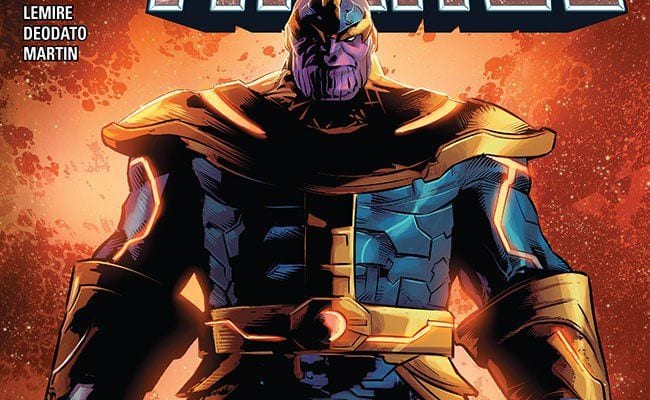
In the days of Saturday morning cartoons full of superheroes who tell kids to eat their vegetables, it wasn’t necessary for villains to be that complex. Kids don’t need character complexities on the level of a Joss Whedon movie. They just need to know who the heroes get to beat up and which toys they need to beg their parents to buy for them.
Flash forward to an era when Lex Luthor can join the Justice League and Dr. Doom can become the new Iron Man. The general trend in villains is to move away from the unapologetic, mustache-twirling evil that that leaves no room for complexity. It’s no longer enough to just establish that a character is evil and needs to be punched by Captain America. That character needs depth and purpose to give context to their evil. It can make for a richer narrative, but it can also make for daunting challenges.
So if Lex Luthor and Dr. Doom can gain greater depth as characters, why not Thanos? Well, that’s a loaded question because in terms of pure, unfettered evil, Thanos is the gold standard of the Marvel Universe. His history and backstory leaves very little room for depth. He’s bad to the bone and then some. He seeks to spread death and destruction for reasons that leave little room for complexity. There’s a good reason why he’s called “The Mad Titan”. He’s mad to a point where the traditional rules of logic and character development just don’t apply.
Despite this challenge, Jeff Lemire attempts to add some complexity to Thanos’ narrative in Now Thanos #1. He shows that while the challenge is not insurmountable, it does make for limited results. There’s some intrigue here, albeit the kind that takes a while to develop. Those familiar with Thanos’ mad, merciless history aren’t going to be too surprised by the events of this issue. He shows up, he fights, he murders, and he practices the kind of cruelty that even Dr. Doom would find callous.
For the most part, Lemire tries to keep things fairly simple. This story doesn’t try too hard to tie into the events of Civil War II, Infinity, or any other previous or ongoing event. Instead, it tries to carve a whole new narrative that takes Thanos down both familiar and unfamiliar paths. Some of those paths promise more cruel and callous murder sprees, which is basically just another typical Tuesday for Thanos. Others offer something a bit more novel.
Both those paths are structured around the return of the Black Order and Thane, Thanos’ son. These are elements of Thanos’ narrative that got pushed to the wayside. In some respects, that’s an accomplishment. Most of the elements surrounding Thanos are either dying or already dead. It’s just one of the many challenges in crafting a story around Thanos, but it’s a challenge that adds substance to the story.
That story doesn’t offer much in terms of complexity. Thanos returns to the Black Order, eager to murder a former associate named Corvus Glaive, who dares to lead others with more fairness and less cruelty. Thanos just can’t have that. He deals with Corvus the same way he deals with Drax the Destroyer, the Avengers, or anyone else who has the audacity to continue living in his presence. Once again, his callous cruelty is on full display here. Anyone hoping to see anything less from Thanos will be disappointed, but hardly surprised.

It may not be a very compelling story in terms of depth, but it does set up an important reveal at the end that promises to shake up Thanos’ callous, cruel, death-loving narrative. That reveal comes a little too late to make the earlier events more interesting, but it does create a new potential for Thanos that hasn’t been present in his story for quite some time.
This also creates opportunities for characters like Thane and Starfox to be more than just another couple of characters that Thanos desperately wants to kill. While they don’t contribute much in terms of stopping Thanos’ latest murder spree, they do help set up some new conflicts. They’re both somewhat undeveloped in terms of their role in this series, but their history with Thanos ensures they give some much-needed weight to the story.
That history is pretty much the only thing Thane and Starfox have going for them in the context of this story. They carry themselves with the same charisma as Corvus, which is to say they’re somewhat forgettable. They don’t say anything too memorable. They don’t do anything that’s too defining. Their only role is to reveal something important about Thanos. That may be an important component to the story, but only to the extent that they’re glorified messengers.

While Now Thanos #1 succeeds in creating renewed intrigue around Thanos, it’s still an intrigue that takes a while to develop. Other than Thanos himself, there aren’t many other well-developed characters that add the complexity that Thanos’ narrative needs. More than anything else, Jeff Lemire follows the formula for a Thanos story. It’s full of death, destruction, and murder. Those elements are to Thanos what Captain America’s shield is to Steve Rogers. They help define Thanos on a fundamental level.
Lemire gets all the fundamentals right in Now Thanos #1. He also succeeds in creating novelty and nuance, but only to the extent that he sets it up. There’s not much else to give Thanos or his supporting cast any depth to his story. Thanos is still a long, long way from being on the same level as Victor Von Doom, Lex Luthor, or even Walter White in terms of character development. At the very least, this is a good first step and even for a mad titan, that’s the most important step he can take.

